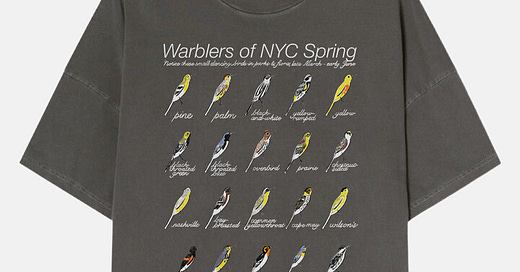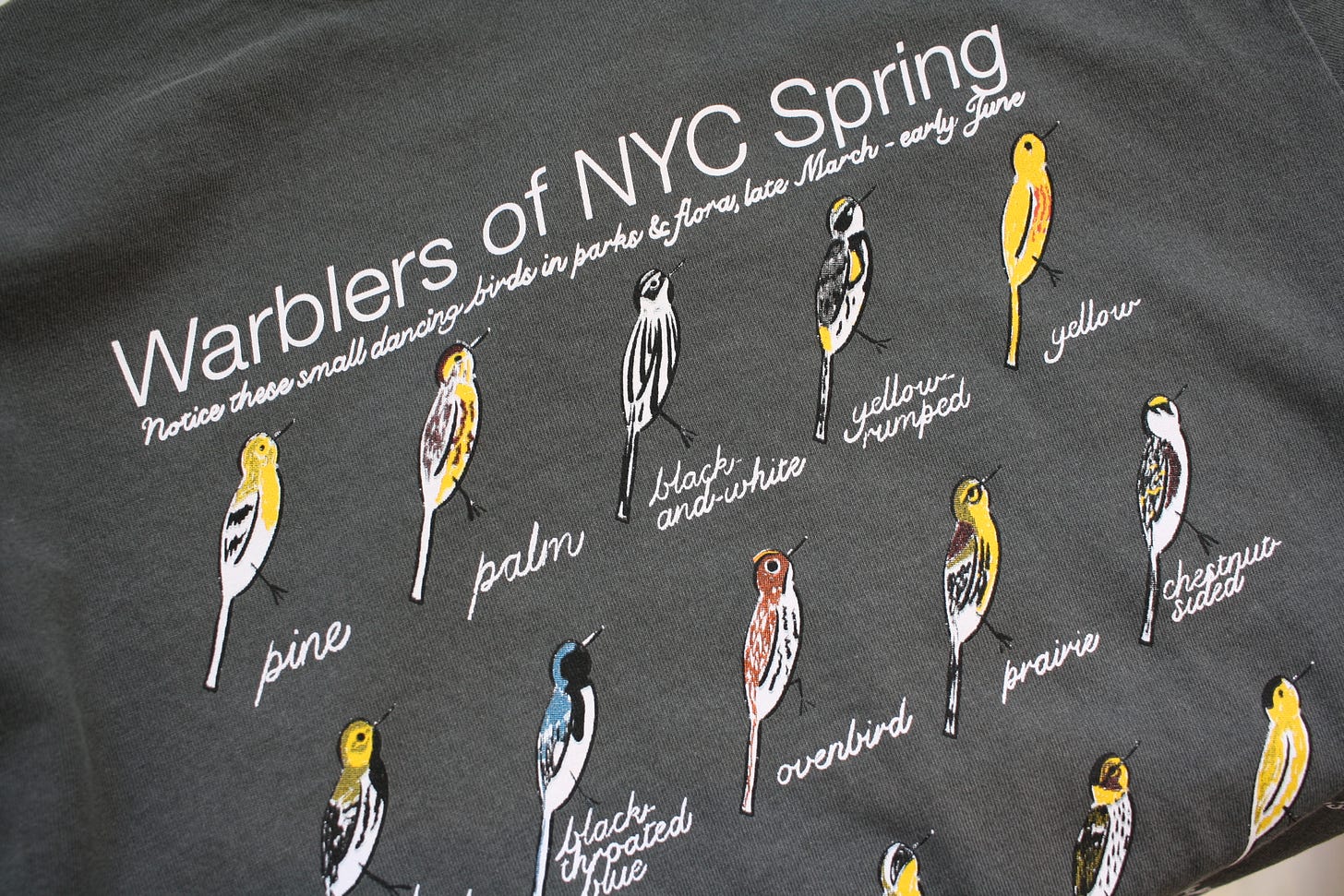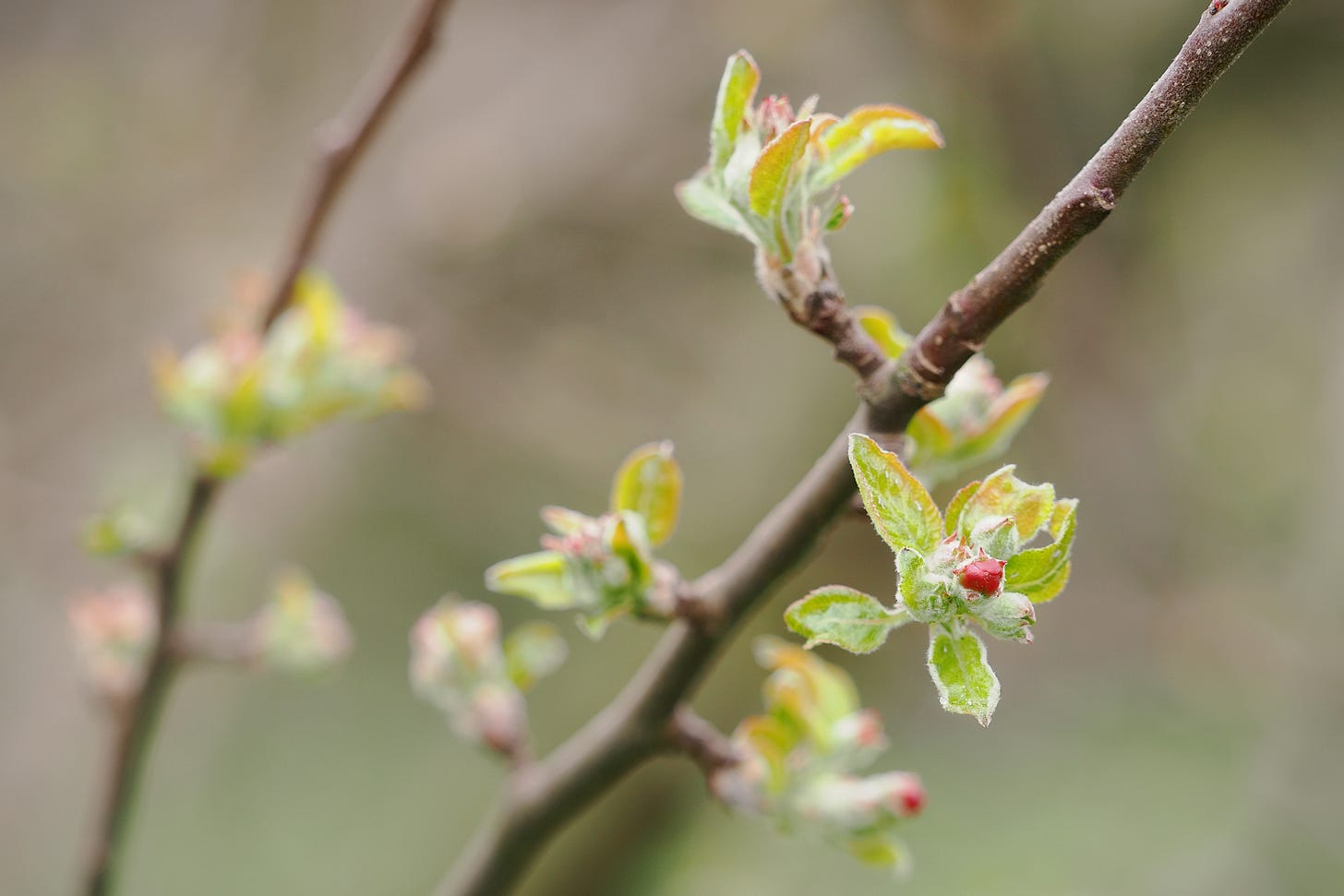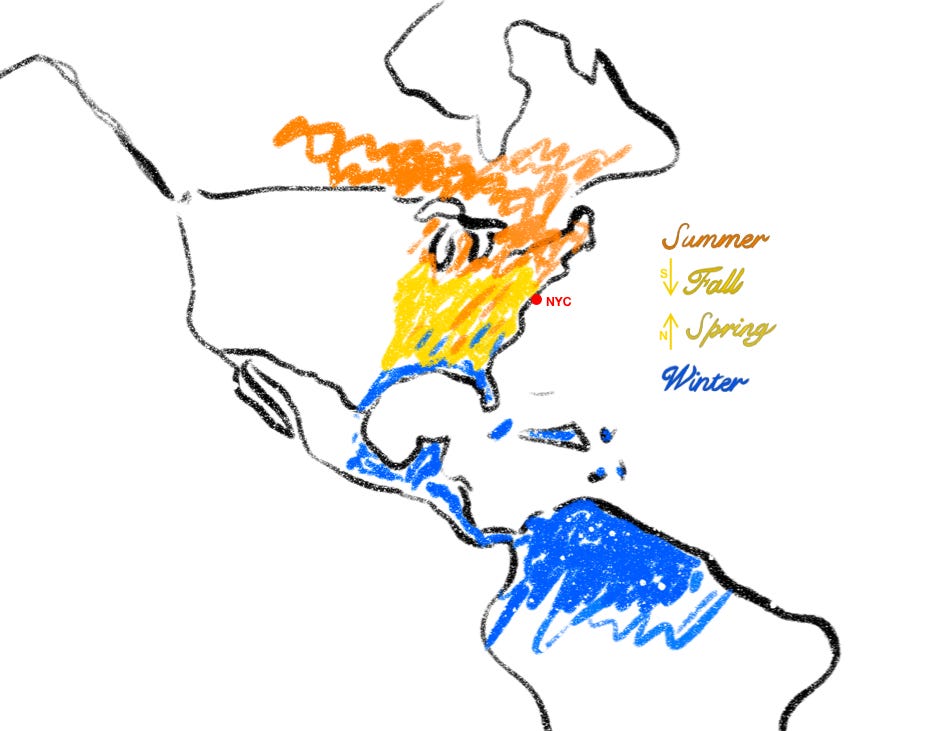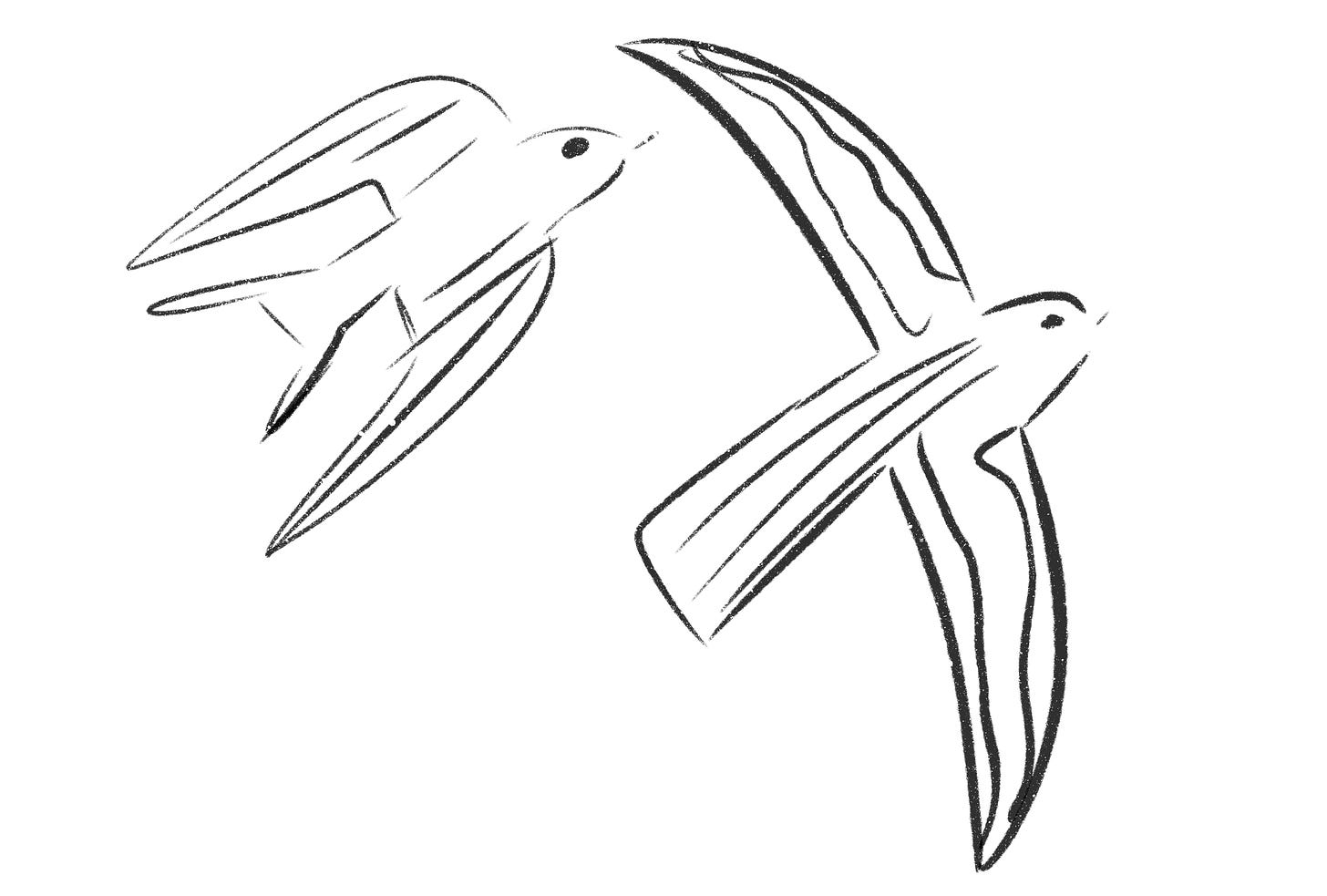Hi again, birding baddies!
This edition of The Noticer’s Monthly is mostly about spring migration. If you’re unfamiliar with that concept, you’re in for a real treat! If you were blown here by storm (or the NYC Bird Alliance article) and don’t know who we are: The Noticer’s Monthly is a reader-supported rag by McGolrick Bird Club and birding.website. It’s where we share educational tidbits, thoughts and feelings, and (duh) noticings from our little corner of Brooklyn.
Yours,
MBC and B.W
QUICK UPDATES & ANNOUNCEMENTS
1.) REMINDER: Did you order your members-only socks?
2.) BOOKMARK: Your favorite (?) birder wrote an article for NYC Bird Alliance.
3.) NEW SHIRT ALERT: Every spring (late March - early June), New York City is descended upon by technicolor clouds of tiny, dancing warblers—from as far away as the Amazon. Most stay just a few short weeks—resting, feeding, swirling through our parks in a radiant blur, and then vanishing toward ancient breeding grounds like Canada’s boreal forest.
Among the whole migratory cast—sparrows, kinglets, vireos, tanagers, thrushes—warblers hold a mystical power over New Yorkers prepared to notice them.
So yeah… we went ahead and did a 100% heavyweight cotton, ethically sourced t-shirt featuring hand-drawn illustrations of the 25 most findable ones:
It’s educational. It’s a conversation starter. It’s perfect for casual outings and warbler summoning circles alike.
👉 Get yours here.
👉 Review our Complete-ish Guide to Eastern Warblers here!
MICRO-SEASON: APR 7 - APR 20
‘Round these parts, we don’t give a hoot about corporate time. (Eat poop, “Q2.”) We honor micro-seasons—the everyday proof of the cosmic dance between Earth, our breathing, blooming Mother, and Sun, the eternal muse to whom she currently bows.
This micro-season, in McGolrick Park, our proxy for NYC and perhaps even larger swathes of the eastern U.S., one noticed:
Leaves appear on Tulip Trees, Silver Lindens, Hawthorn, Silver Maples, Willow Oaks, Scarlet Oaks, Ginko, European Hornbeam and Oakleaf Hydrangeas · Apple and London Planetree buds · Hyacinth flowers · First of season Laughing Gulls, Ruby-crowned Kinglets, Chimney Swifts, Blue-headed Vireos, Black-and-white Warblers
And here’s a full list of McGolrick birds:
Laughing Gull · Chimney Swift · Carolina Wren · Blue-headed Vireo · Palm Warbler · Pine Warbler · Yellow-rumped Warbler · Black-and-white Warbler · Ruby-crowned Kinglet · Golden-crowned Kinglet · Hermit Thrush · Brown Creeper · American Kestrel · Dark-eyed Junco · White-throated Sparrow · Song Sparrow · Swamp Sparrow · Chipping Sparrow · Tufted Titmouse · Black-capped Chickadee · White-breasted Nuthatch · Red-tailed Hawk · Cooper’s Hawk · Common Grackle · Downy Woodpecker · Red-bellied Woodpecker · Northern Flicker · Yellow-bellied Sapsucker · Northern Cardinal · Blue Jay · Fish Crow · American Crow · Common Raven · Double-crested Cormorant (flyover) · Canada Goose (flyover) · Plus the virtually always present in urban parks: Rock Pigeon, European Starling, American Robin, House Sparrow and Mourning Dove
👉 Nota bene: The birds listed above are from the entire micro-season, not just our Saturday outings! 👉 Spring and summer skies in NYC—and across much of the Eastern US—belong to the Chimney Swift and Laughing Gull. Often heard before seen, these flyovers define the city’s warm-weather soundtrack. Learn their buzzes and cackles! 👉 Review our gull lesson here. 👉 Review our swifts & swallows lesson here.
MICRO-LESSON: EASTERN MIGRATION CHEAT SHEET
Each spring and fall, billions of birds migrate along one of several ancient north-south routes stretching from the Arctic to South America. NYC—once a paradise of estuary, marsh, and inlet; now a disfigured landscape of parks, coastlines, and tree-lined streets—still serves as a critical rest stop for tired and hungry birds.
Spring migration is fast, fragile, and astonishing—an invisible river of wings flowing overhead, mostly at night! 🤘😭
Here’s a wildly oversimplified sketch of how migration tends to work east of the Rockies. Species—let alone individual birds—don’t adhere perfectly to this map. It’s meant to give you a general sense of the spectacle.
Instead of hammering you with every single migrating bird species you could possibly try to learn, we continue our cheat sheet by highlighting a few types you’re likely to encounter in Brooklyn parks—ones you oughta have at least a beginner’s awareness of. You’ll get a quick sketch of their lewk, a breakdown of their size and standout features, plus a few linked species to explore if you’re really feeling the funk.
The important thing is: if you start to feel overwhelmed, fall back. Don’t overthink it. Seriously, don’t worry. Studying pictures and words is way harder than learning from real-life experience. The hope here is that one of these types—maybe even a specific species, whether it’s the name, the shape, the weird doodle, or something in the description—gets you just curious enough that you have to go ego-killing (a.k.a. birding) this spring.
Here we go:
Thrushes: Medium-sized, full-bodied birds with straight, slender bills and long legs; built for moving quietly through leaf litter.
Species to learn: Hermit Thrush · Swainson’s Thrush · Veery · Wood Thrush
Vireos: Slightly bigger than warblers. Vireos have telltale eye-markings—either spectacles or brows + under-eye bags.
Species to learn: Blue-headed Vireo · Red-eyed Vireo · Warbling Vireo · Yellow-throated Vireo · White-eyed Vireo
Flycatchers: Medium-large to medium-small birds with upright postures, expressive faces, and wide bills designed for catching insects in mid-air. Often seen perched on bare or leafless branches, from which they fly out then return.
Species to learn: Great Crested Flycatcher · Eastern Kingbird · Eastern Wood-Pewee · Least Flycatcher
Tanagers: Medium-sized songbirds with solid bills and vibrant plumage. They often sport tropical colors like fiery reds and sunny yellows. (This doodle does them an injustice!)
Species to learn: Scarlet Tanager · Summer Tanager
Kinglets: Tiny and round, barely larger than a leaf, constantly in motion.
Species to learn: Ruby-crowned Kinglet · Golden-crowned Kinglet
Wrens: Small and round with short wings and slightly curved bills; tails often cocked, always on alert.
Species to learn: House Wren · Carolina Wren · Winter Wren
Swallows & Swifts: Fast-flying, sleek birds with long wings. They’re built for aerial acrobatics and are often seen soaring in open spaces. Swallows fly low around open fields or water features, while swifts are commonly seen circling above urban areas.
Species to learn: Barn Swallow · Tree Swallow · Chimney Swift
Grosbeaks: Medium to large songbirds with thick, powerful bills and heavy bodies; unmistakably solid.
Species to learn: Rose-breasted Grosbeak · Blue Grosbeak
Orioles: Medium-sized, slim and long-tailed with slightly curved bills and striking orange and yellow feathers; light on their feet, often high in the trees. Their sweet, melodious songs sound a bit like staccato (or drunk) robins.
Species to learn: Baltimore Oriole · Orchard Oriole
Warblers: Small and slim with fine, pointed bills; shaped for moving quickly through leaves, pausing only briefly.
Species to learn: Get the shirt, sister-brother!
Miscellaneous:
Brown Thrasher: Large, long-bodied, streaked bird with a strong, slightly curved bill. (Drawn above)
Blue-gray Gnatcatcher: Tiny and delicate, with a long tail and a fine bill, often flitting through shrubs and trees in search of insects.
Gray Catbird: Medium-sized, slate-gray bird with a smooth, sleek body and a distinctive “cat-like” call.
How’d this go? Don’t hesitate to send questions and comments our way by simply replying to this email, chatting in Substack, or DMing. Or just holler IRL. K, bye!


